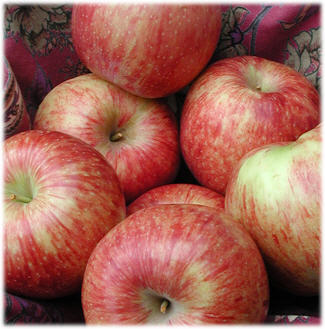 | |
|
Our lives,
so seemingly small, ripple out to the whole universe as tiny whispers like the sounds of butterfly wings, and the clear voice of the living truth. -J.L.D. |

I still remember the taste and texture of the apples from my childhood—crisp, juicy, with a mouth watering, sweet tartness. A neighborhood playmate lived in an old farmhouse, complete with a large gravenstein apple tree in their untended yard. My daily mantra regarding the apples was, are they ripe yet? As they slowly grew and matured, I ached to pluck them from the tree. After what seemed like an eon, the fruits were ready, and I devoured them day after day.
 Now that it's apple season, we're enjoying eating them daily. Their aroma emits a perfume that floods the kitchen—nothing like the apples in the grocery store coolers. We love the refreshing tangy sweetness of sliced apples, or as juice—enjoyed plain, or with lemon and ginger, or greens.
Now that it's apple season, we're enjoying eating them daily. Their aroma emits a perfume that floods the kitchen—nothing like the apples in the grocery store coolers. We love the refreshing tangy sweetness of sliced apples, or as juice—enjoyed plain, or with lemon and ginger, or greens.
Apple Juice with Lemon and Ginger:
Ingredients (serves 2):
4 organic apples, washed and cored.(Some of our favorites are Fuji, Pink Lady, Cameo, Jonagold, etc) 1-2 tablespoons ginger root (about 1/2 inch) 1 lemon, peeled Directions:
Cut fruits into pieces and push through juice hopper. Dilute juice to desired sweetness. Drink immediately. Enjoy! Variations:
Try apple juice mixed with peppermint tea—it's super refreshing. Or apples with blackberries—what a gorgeous color and amazing taste! A Little Story: Cultivating the Wild In preparing for this week's Healing Feast, we wanted to learn down the history of wild apples. In an article by Habitats, A Fact Sheet Series on Managing Lands for Wildlife by the University of Maine Cooperative Extension, we learned that apples, along with pears, plums, quinces, peaches, cherries, strawberries, raspberries and blackberries, all belong to the rose (Rosaceae) plant family, which originated some eighty million years ago! We first became aware of wild food versus human food in 1970 when we lived near Sidney, BC. We were renting a beautiful waterfront home (for only $150.00 a month!) with gardens and fruit trees. Rex was outside and saw some wild strawberries growing at the edge of the tended area. He went to pick some, and received a sharp, distinct impression "These are for the wild animals. You have your own food!" In The Findhorn Garden: Pioneering a New Vision of Man and Nature in Cooperation, we read that nature spirits require a place of their own in the garden that is left untouched by man—with no pruning or tampering in any way. The benefits that nature spirits bring are nothing short of magical—the space feels alive and has healing and nurturing energies. Otherwise, there is an empty, or boring, feeling.  Painting by Janet Doane One of our dreams is to see the land around our homes revert back to the wild. Collectively, we've taken so much natural habitat away from the living creatures that it makes sense to us to start finding ways to give the land back. Planting native cultivars will provide food for the wildlife over many years to come. If we allow portions of our gardens to revert back to the wild—or replace lawns with meadows of perennial wildflowers for the butterflies, birds, bees, and other insects, or with various wild grasses to nourish small animals, then we are really helping in a fundamental way. See American Meadows for wildflower seeds Without a lawn, the water could be redirected to grow fruit trees, and an abundance of veggies. Just think—the possibilities for having fresh organic produce at our doorsteps is astounding! No carbon footprint, no wilted lettuce, no irradiated food! We'd be healthier too, and spend much more time outside in the sun, exercising in the garden, getting stronger all the while. These issues are complex, yet we feel that the earth's crisis is calling us to evolve, to become more conscious, more loving, and caring. (Interestingly, a line from a song on the radio was playing as I wrote this section. The man sang, I'm going to try a little harder!) What a good practice—applying a little more effort, breaking through inertia and comfort zones. These may be difficult lessons for all of us to find solutions for, yet through the unleashing of our creative energies and following our intuition, we can co-create with Gaia and build a better world for ourselves, our children, and all generations to come.  |









